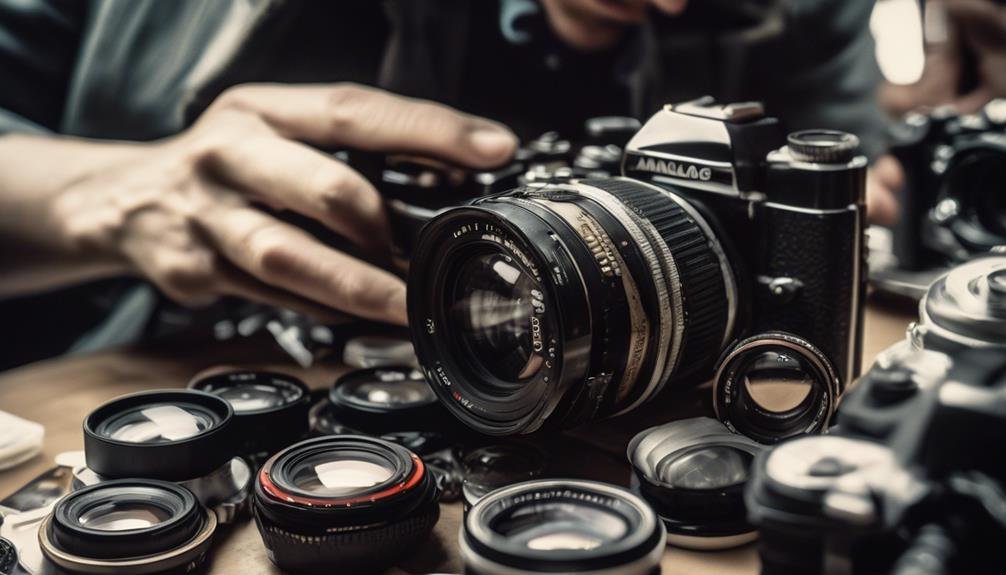
When it comes to capturing action shots with mirrorless cameras, it's like trying to catch a fleeting moment in the wind. The key to freezing that split-second movement lies in mastering the interplay of shutter speed, autofocus, and the right lens. In this discussion, we'll uncover three essential tips that will elevate your action photography game using mirrorless cameras. Whether you're aiming to freeze the motion of a fast-paced sporting event or the fluidity of a dancer mid-performance, these tips will ensure that your mirrorless camera becomes an extension of your creative vision.
Understanding Shutter Speed
Understanding shutter speed is crucial for capturing dynamic action shots with mirrorless cameras. When you want to freeze motion in your action shots, a faster shutter speed is essential. This means using a setting such as 1/500 or 1/1000 of a second to capture crisp, clear images of moving subjects. The faster the subject is moving, the higher the shutter speed you will need to freeze the action.
On the other hand, if you want to create a sense of motion in your images while keeping the subject sharp, a slower shutter speed can achieve this effect. This technique is often used in sports photography to convey a sense of speed and energy. However, it's important to note that using a slower shutter speed may result in a blurred background if the camera is not perfectly still. To compensate for this, consider using a tripod or a lens with image stabilization to ensure that only the background is blurred, while the subject remains in focus.
Mastering shutter speed is a powerful tool for any photographer looking to capture dynamic action shots with mirrorless cameras. Whether you want to freeze motion or create a sense of movement with a blurred background, understanding how shutter speed works is essential for achieving your desired results.
Utilizing Continuous Autofocus
Continuous autofocus is a valuable feature in mirrorless cameras, allowing photographers to maintain sharp focus on moving subjects throughout a series of shots. When capturing action shots, utilizing continuous autofocus is crucial for tracking subjects and ensuring that the images remain in focus, especially when dealing with fast movement.
| Advantages of Continuous Autofocus |
|---|
| 1. Precision: Ensures accurate and consistent focus on moving subjects. |
| 2. Flexibility: Allows the photographer to concentrate on composition and timing while the camera maintains focus. |
| 3. Efficiency: Saves time by automatically adjusting focus, enabling the capture of decisive moments. |
| 4. Reliability: Reduces the likelihood of missing critical shots due to focus errors. |
Continuous autofocus empowers photographers to concentrate on the creative aspects of capturing action shots while the camera handles the technical aspects. This feature is especially beneficial when dealing with unpredictable or rapid movements, such as in sports or wildlife photography. By leveraging continuous autofocus, photographers can enhance their ability to capture dynamic and impactful images, ensuring that every moment is preserved in sharp detail.
Selecting the Right Lens

When selecting the right lens for action shot photography, it's essential to consider the focal length and maximum aperture to ensure optimal performance in capturing fast-moving subjects. Lens compatibility with your mirrorless camera is crucial, so consider options specifically designed for action photography. Look for lenses with a variety of focal length options, such as telephoto or zoom lenses, which allow for greater flexibility in framing and capturing distant subjects. A longer focal length, such as a 70-200mm, can bring distant subjects closer and is well-suited for sports or wildlife action shots. Additionally, a wider maximum aperture, like f/2.8, enables faster shutter speeds, crucial for freezing motion in dynamic environments. This is particularly beneficial when shooting in low light conditions or wanting to achieve a pleasing background blur while keeping the subject in focus. By carefully considering these factors, you can select a lens that complements your mirrorless camera, providing the versatility and performance needed to capture stunning action shots.
Frequently Asked Questions
What Are Some Recommended Settings for Capturing Action Shots in Low Light Conditions With a Mirrorless Camera?
Shooting action in low light with a mirrorless camera? Try these tips: tweak ISO for better exposure, open up the aperture for more light, and use a faster shutter speed to freeze movement.
How Can I Effectively Capture Fast-Moving Subjects in Challenging Environments, Such as Sports Events or Wildlife Photography?
To effectively capture fast-moving subjects in challenging environments, such as sports events or wildlife photography, we use the panning technique and focus tracking. Burst mode and adjusting shutter speed also help freeze the action and get sharp images.
Are There Any Specific Techniques for Capturing Action Shots With a Mirrorless Camera That Can Help Minimize Motion Blur?
Panning technique and proper shutter speed are pivotal for action shots with mirrorless cameras. Utilize autofocus modes and burst shooting to track subjects and capture decisive moments. These techniques minimize motion blur and ensure sharp, dynamic images.
What Are Some Tips for Composing Dynamic and Visually Striking Action Shots With a Mirrorless Camera?
When capturing action shots with mirrorless cameras, we focus on the subject's movement and energy. Tips include choosing fast lenses, using burst mode, and applying rule of thirds for dynamic composition. Lighting techniques emphasize sharpness and contrast.
Can You Provide Advice on Post-Processing Techniques for Enhancing Action Shots Taken With a Mirrorless Camera?
We've found that post-processing techniques can significantly enhance action shots taken with mirrorless cameras. Color correction, sharpness enhancement, noise reduction, and contrast adjustment all play a crucial role in bringing out the best in these dynamic images.
